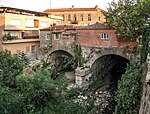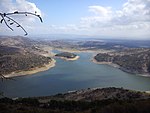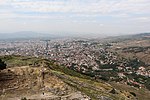The "Red Basilica" (Turkish: Kızıl Avlu), also called variously the Red Hall and Red Courtyard, is a monumental ruined temple in the ancient city of Pergamon, now Bergama, in western Turkey. The temple was built during the Roman Empire, probably in the time of Hadrian and possibly on his orders. It is one of the largest Roman structures still surviving in the ancient Greek world. The temple is thought to have been used for the worship of Egyptian gods – specifically Isis and/or Serapis, and possibly also Osiris, Harpocrates and other lesser gods, who may have been worshipped in a pair of drum-shaped rotundas, both of which are virtually intact, alongside the main temple.
Although the building itself is of an immense size, it was only one part of a much larger sacred complex, surrounded by high walls, that dwarfed even the colossal Temple of Jupiter in Baalbek. The entire complex was built directly over the River Selinus in a remarkable feat of engineering that involved the construction of an immense bridge 196 metres (643 ft) wide to channel the river through two channels under the temple. The Pergamon Bridge still stands today, supporting modern buildings and even vehicle traffic. A series of tunnels and chambers lies under the main temple, connecting it with the side rotundas and giving private access to different areas of the complex. Various drains, water channels and basins are located in, around and under the main temple and may have been used for symbolic reenactments of the flooding of the Nile.
The temple was converted by the Romans into a Christian church dedicated to St John but was subsequently destroyed. Today the ruins of the main temple and one of the side rotundas can be visited, while the other side rotunda is still in use as a small mosque.









